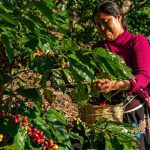Changes in land use and other human activities such as agricultural monocultures, extensive livestock farming and the construction and use of infrastructures can have a very detrimental joint effect on bat populations, even leading to their total disappearance in some nations.
A clear case is that of Colombia. The tropical dry forest, habitat of various species of bats, is in a high degree of threat due to the aforementioned factors. Human intervention in this habitat has left less than 10% of the original coverage of this type of forest, and only 5% has some formal protection measure.
An investigation by the National University of Colombia (UNAL) reveals that these changes can lead to the local extinction of certain species and the loss of key ecosystem services.
Biologist María Camila Valdés Cardona, one of the researchers, says that the degradation, fragmentation and loss of ecosystems would also lead to a decrease in the richness of species.
Typically, to know where the bats are, the “island biogeography theory” is used, which, as its name indicates, imagines the habitat as an ocean with islands where the animals can live surrounded by a homogeneous matrix (water) , and where they cannot live (what is known as “no habitat”).
“That way of looking at it simplifies the problem because it is not known how diverse or heterogeneous this matrix is: although it is usually only spoken of ‘habitat’ and ‘non-habitat’, the latter is made up of many things, it may be that what surrounds to these ‘islands’ is degraded forest, crops, infrastructure, bodies of water, and that they are transformed does not necessarily mean that animals cannot take advantage of them; In addition, the mechanisms of these animals to adapt to the modification of the habitat have not yet been fully established”, explains the biologist Valdés.
In the Caribbean and in the department of Santander (Colombia), bats gather in large aggregations and take refuge in caves; for example, in the municipality of Curití (Santander) specimens were found in a cave called “Macaregua”, as well as in caves in the corregimiento of El Morro in Tubará (Atlántico).
The species Pteronotus personatus forms colonies at Fort San Fernando de Bocachica (Cartagena, Colombia). Photos: Camila Valdés / UNAL)
Images from the Sentinel 2 satellite from 2019 were used to determine where the specimens were found and their relationship with the environment, and thanks to the Random Forest algorithm it was determined if there were bodies of water, human infrastructure, soil 4 kilometers around each sampling site. bare, forest, bushes, grasslands, crops, cattle pastures, mangroves or sea.
The most important finding is that in order to maintain the richness and diversity of bat communities in the tropical dry forests of northern Colombia, it is very necessary for there to be forest cover and for the matrix surrounding the “islands” where these communities live to be heterogeneous so that there is the variety of space, food and shelter resources that different species need.
This means that if there is only one type of landscape surrounding those patches of forest, the result is a loss of diversity for the bats that live there.
If the tropical dry forest is deforested to plant monocultures, surely there will be many bats that feed on these types of plants, but some ecosystem services such as seed dispersal and control of insects and small vertebrates will be negatively affected, because bats those in charge of these will no longer live in the area.
It was also found that diversity and equity –or how many species of bats can live in the area– are negatively affected by the change in land use to agricultural activities such as cattle pastures, grasslands and crops.
For example, bats that feed on insects, nectar and fruits will be more diverse when the vegetation is also diverse, and nomadic bats, which feed on fruit, are favored when the surrounding landscape is diverse, precisely because it is nomads and be able to reach varied resources.
According to the research, the negative impact on bat communities, generated by covers with an agricultural tendency, or lands that allow agricultural production due to their soils, could also be related to the loss of landscape diversity.
The massive transformation of land uses leads to the erosion of heterogeneity and permeability of the matrix, which could affect more species with low dispersal capacity or with specialized diets. This in turn would lead to a process of local extinction and community homogenization and, finally, to the loss of ecosystem services. (Source: UNAL Agency)






![[Img #74785]](https://thelatestnews.world/wp-content/uploads/2025/01/They-locate-the-place-of-origin-of-electrical-currents-in-150x150.jpg)




![[Img #66850]](https://thelatestnews.world/wp-content/uploads/2022/08/Bats-could-disappear-from-some-countries.jpg)
![[Img #74785]](https://thelatestnews.world/wp-content/uploads/2025/01/They-locate-the-place-of-origin-of-electrical-currents-in-300x200.jpg)

Add Comment